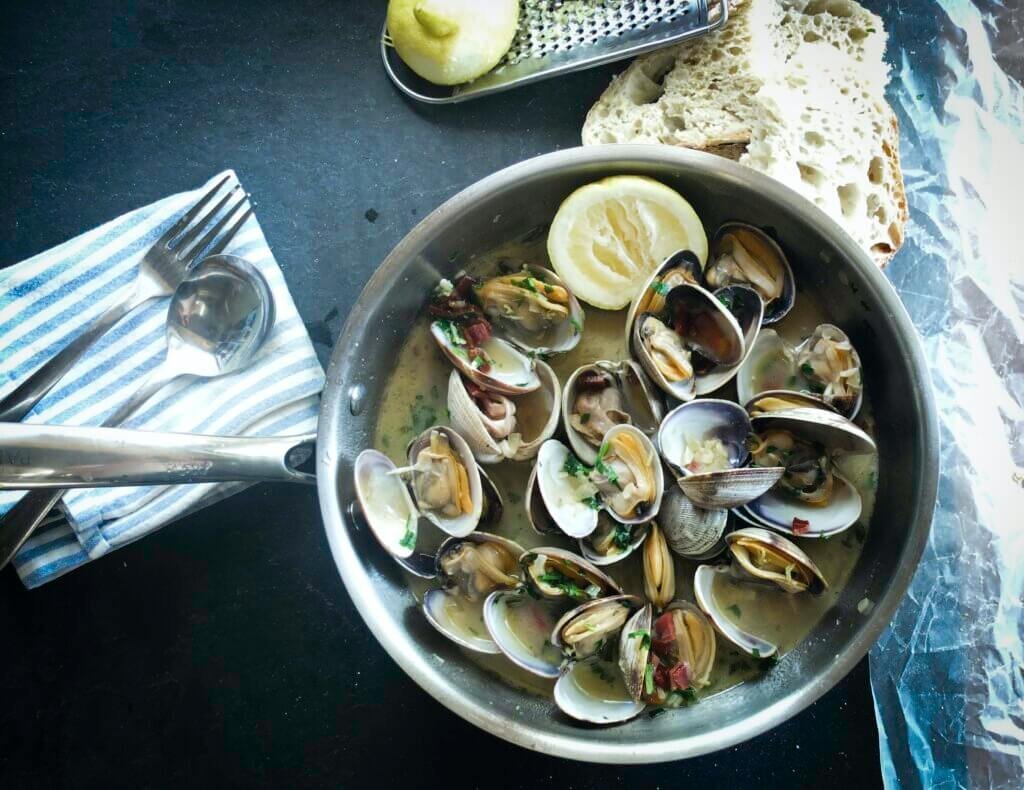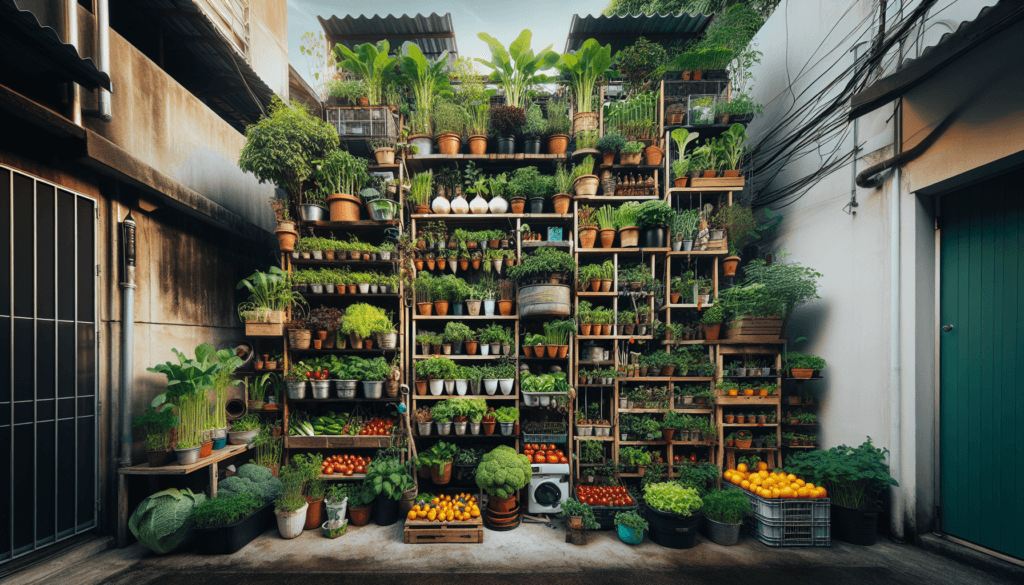Are you interested in growing your own food but don’t have a large backyard? Look no further! In this article, we will explore the best ways to grow food in a small urban garden. Whether you have a tiny balcony or a small plot of land, we have you covered. Discover innovative techniques, space-saving hacks, and expert tips to help you cultivate a bountiful garden in the midst of the concrete jungle. Get ready to transform your urban space into a thriving oasis of fresh produce and delicious flavors.

Using Vertical Space
Hanging Baskets
One of the best ways to make use of vertical space in a small urban garden is by utilizing hanging baskets. Hanging baskets are perfect for growing a variety of plants such as flowers, herbs, and even vegetables. They can be hung from hooks mounted on walls, fences, or even overhead structures like pergolas or trellises. Hanging baskets not only add visual interest to your garden but also help maximize space by allowing you to grow plants at different heights.
Wall Planters
Another great way to maximize vertical space is by using wall planters. Wall planters are specially designed containers that can be attached to walls or fences, allowing you to grow plants vertically. These planters come in a variety of sizes and styles, making it easy to find the perfect ones for your garden. With wall planters, you can create a stunning living wall filled with lush greenery or colorful flowers. They are an excellent option for those with limited ground space but still want to enjoy the benefits of a garden.
Living Walls
If you’re looking to take vertical gardening to the next level, consider creating a living wall. A living wall is a vertical garden made up of an array of plants growing on a vertical structure or trellis. With the right combination of plants, a living wall can be a beautiful and vibrant addition to your small urban garden. Living walls not only provide a striking visual display but also offer numerous environmental benefits such as improved air quality and insulation. They can be created using a variety of plants, including herbs, flowers, and even small vegetables.
Container Gardening
Choosing the Right Containers
When it comes to container gardening, choosing the right containers is crucial. Opt for containers that are large enough to accommodate the root systems of your chosen plants. Ideally, containers should have drainage holes to prevent waterlogging. Consider the material of the containers as well. Plastic and fiberglass containers are lightweight and easy to move, while ceramic and terracotta containers offer a more aesthetic appeal but may need additional insulation in colder climates.
Ideal Plants for Containers
Not all plants thrive in containers, so it’s important to choose plants that are well-suited for container gardening. Herbs like basil, mint, and rosemary are popular choices for containers due to their compact growth habits. Tomatoes, peppers, and salad greens are also great options for container gardening. Additionally, flowers like petunias, marigolds, and pansies can add color and beauty to your small urban garden.
Proper Soil and Drainage
Container plants rely on the soil within their containers for nutrients and moisture, so it’s important to use a high-quality potting mix specifically formulated for container gardening. This type of soil is lightweight, well-draining, and rich in nutrients. Ensure that your containers have proper drainage holes to prevent water from pooling at the bottom, which can lead to root rot.
Watering and Fertilizing
Container plants have specific watering needs since their root systems are confined to a limited space. It’s important to regularly check the moisture levels of the soil and water your plants accordingly. Avoid overwatering, as it can lead to root rot. Fertilizing is also essential for container plants, as the nutrients in the potting mix can deplete over time. Use a balanced, slow-release fertilizer to ensure your plants receive the necessary nutrients throughout the growing season.
Managing Pests and Diseases
Like any garden, container gardens are susceptible to pests and diseases. Keep a close eye on your plants and promptly address any signs of infestation or disease. Introduce natural predators such as ladybugs or use organic pest control methods to keep pests at bay. Regularly inspect your plants for any signs of disease and promptly remove any affected parts to prevent the spread.
Raised Bed Gardening
Constructing Raised Beds
Raised bed gardening is an excellent option for small urban gardens as it allows you to create a concentrated growing area with improved soil quality. To construct raised beds, you can use materials such as wood, cinder blocks, or even repurposed containers. The dimensions of your raised beds will depend on the available space and your personal preference. Ensure that your raised beds are at a height that is comfortable for you to work with.
Selecting the Right Location
When selecting a location for your raised beds, consider factors such as sunlight exposure and accessibility. Most plants require at least 6 hours of direct sunlight each day, so choose a spot that receives adequate sunlight. Accessibility is also important, as you’ll want to easily reach your plants for watering, harvesting, and maintenance.
Soil Preparation
One of the key benefits of raised bed gardening is the ability to control the quality of your soil. Start by removing any weeds or grass from the area where your raised beds will be placed. Fill your raised beds with a mixture of topsoil, compost, and organic matter to create a nutrient-rich growing environment. This will provide your plants with the necessary nutrients and promote healthy growth.
Planting in Raised Beds
Raised beds offer a convenient way to organize your plants. Consider the mature size of your plants when planning their arrangement in the raised beds. Taller plants should be placed at the back or center of the bed to avoid shading smaller plants. Follow spacing guidelines to ensure adequate airflow and to prevent overcrowding, which can lead to increased pest and disease issues.
Caring for Raised Bed Gardens
Raised bed gardens require regular maintenance to ensure the health and productivity of your plants. Regularly water your plants, ensuring that the soil remains evenly moist. Mulching your raised beds can help conserve moisture and prevent weed growth. Keep an eye out for any signs of pests or diseases and address them promptly. Additionally, periodically replenishing your soil with compost or organic matter will help maintain soil fertility over time.
Hydroponics
Introduction to Hydroponics
Hydroponics is a soilless growing method that allows you to grow plants using nutrient-rich water instead of traditional soil. This technique is particularly ideal for small urban gardens as it maximizes space while providing plants with the optimal nutrients they need for healthy growth. Hydroponics can be done using various systems, including nutrient film technique (NFT), deep water culture (DWC), and vertical hydroponics.
Setting Up a Hydroponic System
To set up a hydroponic system, you’ll need a few essential components such as a reservoir to hold the nutrient solution, a pump to circulate the solution, and a container or growing tray to support the plants. Depending on the system you choose, you may also need grow lights to provide the necessary light for plant growth. Follow the instructions specific to your chosen system for proper installation and setup.
Choosing Suitable Plants
Almost any plant can be grown hydroponically, but some plants are better suited for this method than others. Leafy greens like lettuce, spinach, and kale are popular choices for hydroponics due to their rapid growth and minimal root systems. Herbs like basil and parsley also thrive in hydroponic systems. Additionally, vine plants like tomatoes, cucumbers, and peppers can be grown vertically in hydroponic setups.
Nutrient Management
In hydroponic gardening, nutrients are provided to plants through the nutrient solution. It’s important to properly manage the nutrient levels to ensure plants receive the right balance of macronutrients and micronutrients. Follow the instructions provided with your nutrient solution and regularly monitor the pH and EC levels of the solution. Adjust nutrient strengths as needed based on the growth stage of your plants.
Hydroponic Pest Control
While hydroponic systems are generally less prone to pests and diseases compared to traditional soil-based gardens, it’s still necessary to implement pest control measures. Inspect your plants regularly for any signs of pest infestation and promptly address them. Implement preventive measures such as maintaining a clean system, regularly sanitizing equipment, and providing adequate airflow to prevent the development of pests and diseases.

Intensive Planting
Companion Planting
Companion planting is the practice of growing different plants together to maximize their growth potential and benefit each other. By strategically pairing plants that have beneficial relationships, you can enhance pest control, nutrient uptake, and overall plant health. For example, planting marigolds alongside tomatoes can help repel pests and attract beneficial insects.
Succession Planting
Succession planting involves planting new crops as soon as previous crops are harvested. This efficient planting method allows you to utilize space effectively throughout the growing season and ensure a continuous harvest. As you harvest one crop, immediately plant another in its place. Timing is key when succession planting to take advantage of the right growing conditions and maximize your yield.
Square Foot Gardening
Square foot gardening is a method that allows you to grow a variety of plants in a minimal space. The technique involves dividing your garden area into square-foot sections and densely planting different crops within each square foot. This method maximizes space while providing optimal growing conditions for each plant. It’s a great option for small urban gardens where space is limited.
Interplanting and Interrow Planting
Interplanting and interrow planting involve planting different crops in the same bed or row. This technique allows you to make the most of your available space by utilizing every inch effectively. By combining plants with different growth habits and complementary needs, you can achieve a diverse and productive garden. For example, interplanting fast-growing radishes with slow-growing carrots can maximize space and yield.
Utilizing Microgreens and Sprouts
Growing Microgreens
Microgreens are young, tender plants that are harvested when they are just a few inches tall. They are packed with flavor and nutrients, making them a popular choice for adding a fresh, vibrant touch to meals. Growing microgreens is relatively easy and can be done indoors, making them a perfect option for small urban gardens. Simply sow seeds densely in trays or containers filled with a well-draining soil mix, keep them moist, and harvest when the first true leaves appear.
Growing Sprouts
Sprouts are seeds that have just germinated and are consumed with their tender, delicate sprouts. They are incredibly nutritious and can be grown in a simple sprouting jar or tray. Sprouts are typically ready to harvest within a week and can be added to salads, sandwiches, or stir-fries for an extra burst of freshness and crunch. They require minimal space and are an excellent option for urban gardeners with limited outdoor space.
Benefits of Microgreens and Sprouts
Microgreens and sprouts offer numerous benefits for urban gardeners. They require minimal space and can be grown indoors, allowing you to enjoy fresh greens year-round. They are packed with essential vitamins, minerals, and antioxidants, making them a powerhouse of nutrition. Furthermore, growing microgreens and sprouts is a quick, rewarding process, with most varieties ready for harvest within a few weeks.
Harvesting and Using Microgreens and Sprouts
To harvest microgreens, snip the stems just above the soil level. Rinse them thoroughly before using them in salads, sandwiches, or as a garnish for various dishes. Sprouts can be harvested by cutting the entire sprout cluster just above the roots and rinsing them well. They are best consumed raw to retain their crisp texture and nutritional benefits.

Utilizing Hanging Space
Hanging Herb Garden
A hanging herb garden is a perfect way to utilize hanging space in your small urban garden. Choose a set of herb plants that you enjoy cooking with and hang them in a sunny spot, such as a balcony or near a window. Utilize hanging baskets or specialized herb planters that can be hung from hooks. Not only will a hanging herb garden add a touch of greenery to your space, but it will also provide fresh herbs at your fingertips for cooking delicious meals.
Hanging Vegetable Garden
If you have limited ground space, consider growing vegetables in hanging baskets or planters. Compact, bushy varieties like cherry tomatoes, peppers, and small eggplants can thrive in hanging containers. Hang them in a location that receives at least 6 hours of direct sunlight each day and make sure to water and fertilize them regularly. Enjoy watching your vegetables grow and harvest them for fresh, homegrown meals.
Hanging Fruit Garden
Certain fruit plants can also be grown in hanging containers, allowing you to enjoy a taste of nature’s sweetness on your small urban garden’s limited space. Strawberries, trailing varieties of berries, and small fruit trees like figs and citrus can be grown in hanging baskets or specialized hanging planters. Ensure they receive enough sunlight and provide the necessary care in terms of watering, fertilizing, and pruning. Harvest and savor the delicious fruits as they ripen.
Utilizing Windowsills and Balconies
Container Selection for Windowsills and Balconies
When utilizing windowsills and balconies for gardening, select containers specifically designed for these spaces. Windowsill herb planters are ideal for growing herbs as they fit perfectly on windowsills and provide easy access to sunlight. Balcony railing planters can be attached to railings, allowing you to maximize vertical space without taking up floor area. Choose containers that have proper drainage to prevent water buildup.
Growing Herbs and Small Plants
Windowsills and balconies are well-suited for growing herbs and small plants due to their proximity to sunlight and ease of access. Herbs like basil, thyme, and chives can be grown in windowsill planters, providing you with fresh aromatic herbs for cooking. Small flowering plants like marigolds or pansies can add a pop of color to your windowsills or balcony, creating a vibrant garden oasis.
Choosing the Right Sun Exposure
When gardening on windowsills and balconies, it’s important to determine the sun exposure of your specific location. Most plants require at least 4-6 hours of direct sunlight, so choose plants accordingly. South-facing windowsills and balconies generally receive the most sunlight, whereas north-facing ones receive less direct sunlight. Consider the sun exposure when selecting plant varieties and position your containers accordingly.
Caring for Plants on Windowsills and Balconies
Plants grown on windowsills and balconies require regular care to thrive. Ensure that your plants receive adequate water without being waterlogged. Check the moisture levels of the soil regularly and adjust watering accordingly. Fertilize your plants as needed, following the instructions provided with your chosen fertilizer. Regularly inspect your plants for any signs of pests or diseases and address them promptly. Prune plants as necessary to maintain their shape and promote healthy growth.

Utilizing Roof Gardens
Roof Garden Design and Planning
Creating a functional and aesthetically pleasing roof garden requires careful design and planning. Consider factors such as weight load limits, drainage systems, and safety precautions when designing your roof garden. Determine your specific goals for the garden, whether it’s to grow vegetables, create a relaxing space, or enhance the overall energy efficiency of your building. Consult with professionals if needed to ensure proper design and implementation.
Structural Considerations
Before creating a roof garden, it’s important to assess the structural capacity of your rooftop. Ensure that it can support the additional weight of plants, containers, and soil. Consult with an engineer or building professional to determine the weight load limits and any necessary reinforcements. Additionally, consider the slope and waterproofing of your roof to prevent water damage.
Growing Medium and Waterproofing
Since a roof garden will be subjected to unique growing conditions, it’s important to choose the right growing medium and implement proper waterproofing measures. The growing medium should be lightweight and well-draining, allowing excess water to flow freely. A waterproofing membrane or liner should be installed to protect the roof structure from water damage.
Selecting Plants for Roof Gardens
When selecting plants for your roof garden, consider their ability to withstand the specific growing conditions of a rooftop. Choose plants that are drought-tolerant, adapt well to varying temperatures and wind conditions, and have shallow roots systems. Succulents, ornamental grasses, herbs, and certain vegetables like lettuce and chard are excellent choices for roof gardens.
Irrigation and Maintenance
Proper irrigation is crucial for the success of a roof garden. Since rooftop gardens are often exposed to more extreme weather conditions, they can dry out quickly. Install an efficient irrigation system that provides regular watering to your plants. Regular monitoring and maintenance are essential for the long-term health of your roof garden. Inspect your plants for any signs of stress or pests and address them promptly. Regular pruning, fertilizing, and weeding are also necessary to ensure the garden thrives.
Utilizing Community Gardens
Finding and Joining a Community Garden
If you don’t have access to a personal garden space, consider joining a community garden. Community gardens are shared plots of land where multiple individuals come together to garden and grow food collectively. Research local community garden options in your area and find one that aligns with your gardening interests and location. Contact the organization or group managing the community garden to inquire about plot availability and membership details.
Planning and Planting in a Community Garden
Once you’ve secured a plot in a community garden, it’s important to plan your garden layout accordingly. Take into account the specific rules and guidelines of the community garden, such as plot size restrictions and permitted crops. Plan your garden layout based on the space available and the specific crops you want to grow. Consider factors such as sunlight exposure, water availability, and potential shade from neighboring plots.
Sharing Resources and Knowledge
One of the greatest advantages of community gardening is the opportunity to share resources and knowledge with fellow gardeners. Engage in conversations with other gardeners, exchange gardening tips and advice, and learn from their experiences. Consider organizing communal resources like tools, composting systems, or seed libraries to collectively enhance the productivity and sustainability of the community garden.
Maintaining Your Plot in a Community Garden
Regular maintenance of your community garden plot is crucial to ensure the health and productivity of your plants. Water your plants as needed, taking into account any watering guidelines specific to the community garden. Weed and remove any unwanted plants regularly to prevent them from competing with your crops. Additionally, promptly address any signs of pests or diseases by implementing appropriate control measures.
In conclusion, there are numerous ways to grow food in a small urban garden. By utilizing vertical space, such as hanging baskets, wall planters, and living walls, you can maximize your growing area. Container gardening allows you to choose the right containers and select suitable plants while providing proper soil and drainage. Raised bed gardening offers an opportunity to construct raised beds, select the right location, prepare the soil, plant effectively, and care for your raised bed gardens. Hydroponics provides a soilless method for growing plants and requires the correct setup, suitable plant selection, nutrient management, and pest control. Intensive planting techniques such as companion planting, succession planting, square foot gardening, interplanting, and interrow planting allow you to optimize small spaces while maximizing yields. Utilizing microgreens and sprouts can add freshness and nutrition to your meals, while hanging space, windowsills, and balconies can be used effectively to grow herbs, vegetables, and fruit. Rooftop gardens and community gardens offer additional opportunities for urban gardeners to utilize available space and connect with others who share their passion. With these various methods at your disposal, you can turn your small urban garden into a productive and vibrant oasis of fresh food.


